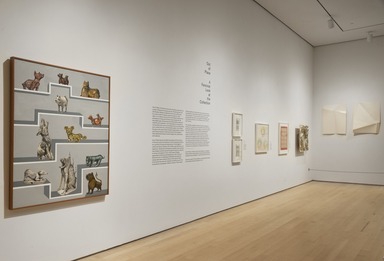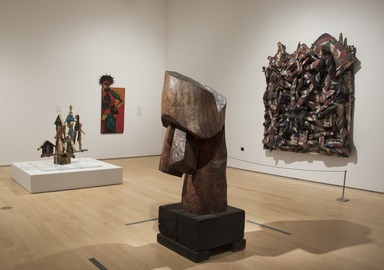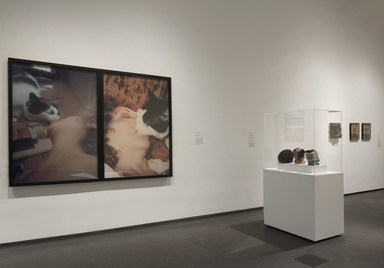

Out of Place: A Feminist Look at the Collection, Friday, January 24, 2020 through Sunday, January 3, 2021 (Image: DIG_E_2020_Out_of_Place_01_PS11.jpg Photo: Jonathan Dorado photograph, 2020)

Out of Place: A Feminist Look at the Collection, Friday, January 24, 2020 through Sunday, January 3, 2021 (Image: DIG_E_2020_Out_of_Place_02_PS11.jpg Photo: Jonathan Dorado photograph, 2020)

Out of Place: A Feminist Look at the Collection, Friday, January 24, 2020 through Sunday, January 3, 2021 (Image: DIG_E_2020_Out_of_Place_03_PS11.jpg Photo: Jonathan Dorado photograph, 2020)

Out of Place: A Feminist Look at the Collection, Friday, January 24, 2020 through Sunday, January 3, 2021 (Image: DIG_E_2020_Out_of_Place_04_PS11.jpg Photo: Jonathan Dorado photograph, 2020)

Out of Place: A Feminist Look at the Collection, Friday, January 24, 2020 through Sunday, January 3, 2021 (Image: DIG_E_2020_Out_of_Place_05_PS11.jpg Photo: Jonathan Dorado photograph, 2020)

Out of Place: A Feminist Look at the Collection, Friday, January 24, 2020 through Sunday, January 3, 2021 (Image: DIG_E_2020_Out_of_Place_06_PS11.jpg Photo: Jonathan Dorado photograph, 2020)

Out of Place: A Feminist Look at the Collection, Friday, January 24, 2020 through Sunday, January 3, 2021 (Image: DIG_E_2020_Out_of_Place_07_PS11.jpg Photo: Jonathan Dorado photograph, 2020)

Out of Place: A Feminist Look at the Collection, Friday, January 24, 2020 through Sunday, January 3, 2021 (Image: DIG_E_2020_Out_of_Place_08_PS11.jpg Photo: Jonathan Dorado photograph, 2020)

Out of Place: A Feminist Look at the Collection, Friday, January 24, 2020 through Sunday, January 3, 2021 (Image: DIG_E_2020_Out_of_Place_09_PS11.jpg Photo: Jonathan Dorado photograph, 2020)

Out of Place: A Feminist Look at the Collection, Friday, January 24, 2020 through Sunday, January 3, 2021 (Image: DIG_E_2020_Out_of_Place_10_PS11.jpg Photo: Jonathan Dorado photograph, 2020)

Out of Place: A Feminist Look at the Collection, Friday, January 24, 2020 through Sunday, January 3, 2021 (Image: DIG_E_2020_Out_of_Place_11_PS11.jpg Photo: Jonathan Dorado photograph, 2020)

Out of Place: A Feminist Look at the Collection, Friday, January 24, 2020 through Sunday, January 3, 2021 (Image: DIG_E_2020_Out_of_Place_12_PS11.jpg Photo: Jonathan Dorado photograph, 2020)

Out of Place: A Feminist Look at the Collection, Friday, January 24, 2020 through Sunday, January 3, 2021 (Image: DIG_E_2020_Out_of_Place_13_PS11.jpg Photo: Jonathan Dorado photograph, 2020)

Out of Place: A Feminist Look at the Collection, Friday, January 24, 2020 through Sunday, January 3, 2021 (Image: DIG_E_2020_Out_of_Place_14_PS11.jpg Photo: Jonathan Dorado photograph, 2020)

Out of Place: A Feminist Look at the Collection, Friday, January 24, 2020 through Sunday, January 3, 2021 (Image: DIG_E_2020_Out_of_Place_15_PS11.jpg Photo: Jonathan Dorado photograph, 2020)

Out of Place: A Feminist Look at the Collection, Friday, January 24, 2020 through Sunday, January 3, 2021 (Image: DIG_E_2020_Out_of_Place_16_PS11.jpg Photo: Jonathan Dorado photograph, 2020)

Out of Place: A Feminist Look at the Collection, Friday, January 24, 2020 through Sunday, January 3, 2021 (Image: DIG_E_2020_Out_of_Place_17_PS11.jpg Photo: Jonathan Dorado photograph, 2020)

Out of Place: A Feminist Look at the Collection, Friday, January 24, 2020 through Sunday, January 3, 2021 (Image: DIG_E_2020_Out_of_Place_18_PS11.jpg Photo: Jonathan Dorado photograph, 2020)

Out of Place: A Feminist Look at the Collection, Friday, January 24, 2020 through Sunday, January 3, 2021 (Image: DIG_E_2020_Out_of_Place_19_PS11.jpg Photo: Jonathan Dorado photograph, 2020)

Out of Place: A Feminist Look at the Collection, Friday, January 24, 2020 through Sunday, January 3, 2021 (Image: DIG_E_2020_Out_of_Place_20_PS11.jpg Photo: Jonathan Dorado photograph, 2020)

Out of Place: A Feminist Look at the Collection, Friday, January 24, 2020 through Sunday, January 3, 2021 (Image: DIG_E_2020_Out_of_Place_21_PS11.jpg Photo: Jonathan Dorado photograph, 2020)
Out of Place: A Feminist Look at the Collection
-
Institutional Space
This section presents artists with diverse ambitions and experiences who grapple with both the history of art and how to situate themselves within it. While historically made for local communities and domestic settings, quilts were hung in art museums in the 1970s as examples of groundbreaking abstraction. This development coincided with a growing feminist interest in researching the cultures and makers of quilts as well as their materials and methods. The history of their collection and display offers a particularly rich example of how objects once considered homespun and of minor historical interest changed art history and museums. The radical act of hanging a quilt next to a contemporary abstract painting made viewers look at both objects differently, and the legacy of painting was expanded to include the influence of these inventive creators of remarkable geometric works of art, from a traditional Amish Bars quilt and Depression-era patterns, to the work of the artists of Gee’s Bend and a reinterpretation of the historical Crazy quilt by the virtuoso Anna Williams.
Conversely, many artists in this section were determined to enter the art-historical mainstream: even as they had to fight their way in, or wait decades for recognition, they understood the value of their work, often single-handedly preserving their legacies. Louise Bourgeois, Chryssa, Louise Nevelson, and Dorothea Rockburne directly engaged with and influenced the history of modern sculpture, just as Helen Frankenthaler, Howardena Pindell, and Joan Snyder challenged hierarchies of modern painting through their unorthodox materials and often unapologetically feminist content. Later generations, including Polly Apfelbaum and Gala Porras-Kim, simultaneously embrace the art-historical past while critiquing the systems of power it has long supported.
-
Place Making
The visibility and institutional support that typically signify an artist’s professional success often coalesce around the systems of art-world power and wealth concentrated in major cities. The Brooklyn Museum’s collection, for example, reflects New York’s role as an epicenter of artistic creativity, made possible by the wealth of the city’s private collector base, support from commercial galleries, and art writing that contextualizes and builds networks for artists. Some artists have long worked outside and against this system, but art history has conventionally categorized their work as “peripheral” or “outsider,” placing them on the fringes of a central energy, thereby reinforcing these hierarchies.
In this section, works by artists with careers based elsewhere are presented in conversation with artworks that explore place as a subject or subtext. Many employ unconventional materials, transforming objects and elements literally at hand into art. A rootedness in a specific environment appears in works by Thornton Dial, Lourdes Grobet, Bessie Harvey, and Ree Morton, while Judith Scott created work with institutional support from the Creative Growth Art Center of Oakland, California. The often unseen spaces of graveyards and prisons figure into artworks by Avon Neal and Ann Parker and Sable Elyse Smith. And key women artists powerfully position themselves as destabilizing agents against sexist or racist art-world hierarchies, as seen in the works of Mary Frank, Dindga McCannon, and Miriam Schapiro. -
Domestic Space
For second-wave feminists of the 1960s and 1970s, art history was incomplete without recognizing artists working within domestic spaces and contexts. Their art was often derided as “women’s work” and “domestic labor” due to its craft connotations and intimate scale. Women, men, and gender-nonconforming people have long made aesthetic objects from everyday materials, alongside their jobs and other daily responsibilities. In this section, artists explore the visual and narrative possibilities of the domestic sphere, sometimes probing its limits.
Despite the physical, economic, and social confines of the domestic, artists such as Hannelore Baron, Mary T. Smith, and Stella Waitzkin created illuminating personal worlds within their art practices—often undertaken at kitchen tables, in yards, and in apartments—while drawing little attention from mainstream society except perhaps for their perceived eccentricities. Betye Saar, May Wilson, and Nancy Youdelman marshal artifacts and images of life in the home to critical and explosive ends, and this approach extends to more recent, ironic works by Petah Coyne, Kaleta Doolin, and Mary Heilmann. Small-scale, often useful, and made from natural materials, works by Mary Frank, Sargent Claude Johnson, Maria Martínez, and James “Son Ford” Thomas challenge notions that great art must be made from precious materials and scaled for an institutional context. -
Out of Place: A Feminist Look at the Collection
Out of Place: A Feminist Look at the Collection examines how context influences the way we see art. Presenting work from the Brooklyn Museum collection by forty-four artists who, for a wide variety of reasons, were once seen as “out of place” in a museum such as this, the exhibition explores how perceptions of value and influence have evolved over the past eighty years. Structured around three distinct spaces of creativity and inspiration—from mainstream art museums, to communities that nurture art-making far from art world centers such as New York City, to the domestic sphere—Out of Place focuses on the ways artists shrewdly change systems of power, particularly museums, where sanctioned cultural legacies have traditionally favored certain backgrounds, experiences, and materials.
Out of Place follows the 2018–19 exhibition Half the Picture: A Feminist Look at the Collection, which showcased feminism as a plurality of voices and experiences in the struggle for justice and equity. Similarly, Out of Place uses feminism as an expansive, intersectional framework to question how museums have shaped collective values through the long-term exclusion of women and people of color. It also traces changing approaches to defining and displaying art, with a focus on feminism’s role in challenging institutional boundaries by making clear what museums have so often ignored. Many of the works here were not originally conceived as part of the conventional encyclopedic museum narrative. These objects address significant histories that have, until recently, been overlooked and undervalued, despite their influence outside the mainstream. On view are recent acquisitions as well as works that have been in the collection for decades; more than half the artworks in Out of Place are now on view for the first time.
This selection juxtaposes artists who directly engage with dominant art movements of the twentieth century with those whose groundbreaking work is made in communities removed from the mainstream art world. Whether challenging the hierarchical organizing structures of museums or self-taught and self-sufficient, these artists favor unorthodox materials and courageous content, requiring museums to reframe the art history they have long advanced. Presenting the creative priorities of multiple art communities and examining how social structures shape our understanding of cultures, Out of Place offers a broad and dynamic picture of modern and contemporary art-making in North America.













![[Untitled]](https://d1lfxha3ugu3d4.cloudfront.net/images/opencollection/objects/size0/CUR.2007.35.JPG)







